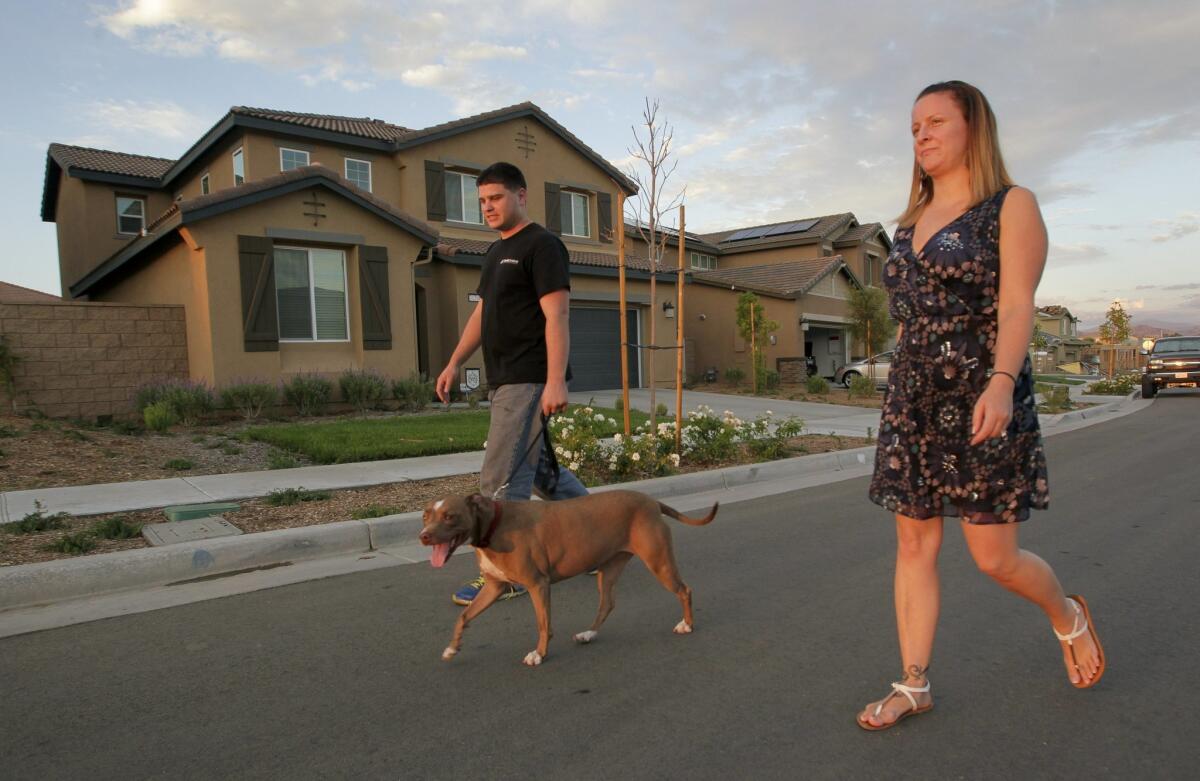Are these homes worth 65-mile commute?
View the Video Would you commute 65 miles for a new house?
If you work in San Diego, you can drive home each day to a new house in a planned development for $350,000.
The modern homes are about 2,000 square feet, have four bedrooms, expansive kitchens, oversized closets, walk-in pantries and two-car garages.
So what’s the catch? A 65-mile, each-way commute, which takes you into Riverside County. That’s where state-of-the-art homes are being constructed with creature comforts like central air conditioning, granite countertops, and landscaping included.
“It’s the best feeling in the world to come home to a house like this,” said Jennifer Kelly, 33, a Mission Valley-based health insurance case worker who moved to a new home in Murrieta in June. “I know an hourlong drive seems like a lot, but for me, especially (after fielding health insurance) complaints, by the time I get home I have already let go of work.”
Would you commute 65 miles to Riverside County for an affordable new home?
Yes 27% (870)
No 73% (2382)
3252 total votes.
If you want a new single-family home in San Diego County, you’re looking at spending $627,500. That’s the third-highest median price on record for San Diego County, and nearly double the region’s post-Great Recession low in 2009, according to CoreLogic DataQuick.
The increased home prices have hit the limits of affordability for many San Diego families that want the comforts of a new home. If they want to stay local, they can rent, or settle for a resale single-family home for a median $490,000, or a resale condo, which hit a median $339,000 in August.
But up Interstate 15 in Riverside County, $339,000 can go pretty far when it comes to real estate.
Consider in that region, the median price for a home rose 13 percent over the past year to $300,000. In that time, however, activity in the market fell 23 percent, meaning values continued to flatten. Prices for new homes constructed in Temecula Valley have hovered around $350,000 over the past year, giving San Diego workers the opportunity to get more for their money, so long as they’re willing to spend more time on the road.
“The further away you are from the economic activity, the center of the cities, the less expensive housing is,” said Alan Gin, economist at the University of San Diego. “There’s a trade-off. You take the better housing and in exchange pay more in terms of gas and also the time of commuting.”
The average San Diegan commutes 11 miles a day. When it comes to the 65 mile-plus drive to work, the last count from the 2011 Census showed there were 38,100 people commuting to San Diego from Riverside County, up from 19,323 10 years earlier. Gin said the activity began increasing in the 1990s, when San Diego home prices began to climb.
The commute
With a regular gallon of gas averaging $3.754, and the average car getting about 23 miles per gallon, commuting five days a week, that’s 650 miles, or 28.26 gallons of gas. Total price? $106.09 a week in gas.
Developers, however, are responding to the increased demand. While historically still low, residential building permits in Riverside County nearly doubled from 2012 to 2013. There are also model homes open along Murrieta Hot Springs Road, with signs usually reserved for tourist attractions pointing to sales offices in all directions. They read, “Model Home Tour, Temecula Valley."
“You come out here, you get more open spaces, backyards, bigger homes, and I think it appeals to families that say, ‘Hey, I want a backyard, I want to have a bedroom for every child,’ and it’s a more-affordable way for them,” said Mark Torres, who leads Lennar’s Inland Empire division.
Jennifer and Patrick Kelly took that tour, and in June moved into a home in a Lennar development called Rancho Bella Vista.
The house has four bedrooms, three bathrooms, a loft, a great room, walk-in pantry, central air conditioning, a pre-landscaped backyard, and a two-car garage. The price? About $404,000. It’s a far cry from what they found those dollars could get them in San Diego County: a three-bedroom, one-bathroom fixer-upper, without a washer-dryer inside. The properties were in areas away from good schools, so not exactly conducive for starting a family.

Previously, the couple was renting a 750-square-foot, two-bedroom apartment in Mira Mesa for about $1,525 a month.
“We had no storage, we were using the second bedroom as a big closet,” Jennifer Kelly said. “Now, I have so much storage, I have empty compartments, empty bedrooms, it’s crazy, you wonder, ‘Where do I put this?’ We even have walk-in pantries.”
As for the commute, Jennifer leaves home in her Acura at 4:45 a.m. each day to get to Mission Valley by 6 a.m. Patrick, 25, heads out at 4:30 a.m. to get to his job in Spring Valley, where he inspects airplane parts.
When they moved, Patrick traded in his pickup truck for a Honda Civic, which gets 40 miles to the gallon. The Kellys each fill up three times a week, but say the money they spend on gas is somewhat of a wash, considering their new home came with solar panels. Their electric bill last month totaled 79 cents.
Stefan West, a Murrieta-based realtor who once commuted to Encinitas, said the Temecula Valley provides the middle class with the best value for lifestyle, with community events, sports leagues, wineries, and movies in the park.
“The irony is that most people who come up here accept the commute by the very process of deciding to look up here,” said West, 43. “I get people from Oceanside, I get people from San Diego, Mira Mesa, Chula Vista, Santee, they are all coming up here because they want good schools for their kids and larger homes, and they’re willing to give on the commute.”
In July, Alvin Lal, a network architect for a utility, his wife, Heather, a graduate student, and their three kids moved to Murrieta. They now live in a 3,800-square-foot, four-bedroom house, which they bought new for $429,000 in a development by KB Home. Before the move, the family was renting a 1,500-square-foot condo in Tierrasanta for $1,800 a month.
Lal, 38, commutes to Sorrento Valley five days a week, and two of those days even farther south to a second job teaching in Chula Vista.
“Even though I could get a loan for $700,000 to $800,000, it didn’t matter if I couldn’t afford the monthly payment,” said Lal, whose home also came with solar panels. “I like to drive as long as the timing is perfect.”
Lennar calculates that San Diego commuters make up 20 percent to 30 percent of the units sold so far in the community, which will reach about 600 units. Similar single-family homes in Del Sur, west of Rancho Bernardo, start in the high $600,000s, while attached homes in the Civita development in Mission Valley are currently going from the high $400,000s.
“It’s certainly much more dense out there, there’s just a lot less land out on the market,” said Torres.
Robert McLeod, the founder of Newland Communities, which has developments in Riverside and San Diego counties, said the Temecula area also attracts people relocating from out of state for jobs in San Diego.
“When you move from outside of California, to California, the price of a house is so expensive that when you’ve sold a really nice home back wherever you came from, that money you clear on it maybe isn’t enough to make the down payment,” he said.
As the residential development continues, the city of Murrieta is continuing efforts to attract more employers. That way, people who move to the area would only have to commute locally to get to work if the opportunities are there.
Bruce Coleman, the city’s economic development director, said the municipality is offering incentives to companies to relocate. For instance, those in leading edge fields like life sciences can rent office space from the city for $1 per year.
“We have a need to rebalance this area, to see the growth of jobs,” he said. “The workforce is in fact here and it’s leaving Murrieta every day to go to Los Angeles County, Orange County and San Diego County, and we want to keep that workforce here, keep our talent here.”
Lal said he plans to stay in Murrieta until his youngest child, now 9, turns 18. Then he’s planning to move to Mission Valley, which he considers to be the central location in San Diego.
For the Kellys, however, it’s all about living in the moment.
“I wanted to own something and live there for the next 10 years or 20 years,” Jennifer Kelly said. “We actually even looked at older homes in Temecula, all the way down to Clairemont and there was nothing that we could find unless it was a condo, and I just don’t feel like owning a condo is something that we wanted to do.”
Get U-T Business in your inbox on Mondays
Get ready for your week with the week’s top business stories from San Diego and California, in your inbox Monday mornings.
You may occasionally receive promotional content from the San Diego Union-Tribune.
